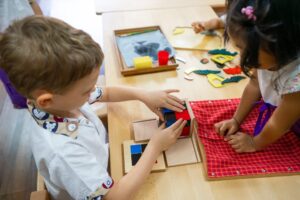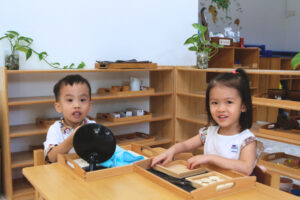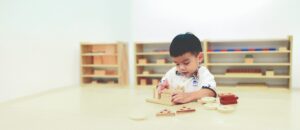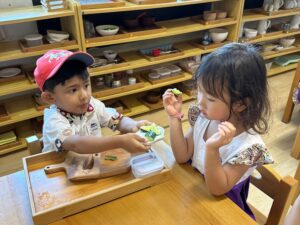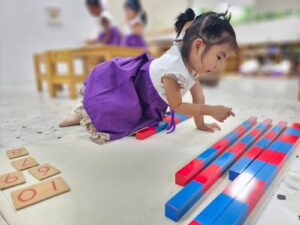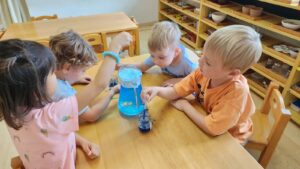Why Sensory Play Matters – Indoors and Outdoors
From the moment they’re born, infants begin learning through their senses. They take in the world not with words or structured lessons, but by touching, smelling, seeing, hearing, and even tasting the environment around them. This is the essence of sensory play — and it is vital to brain development.
Both indoor and outdoor sensory play provides unique and complementary opportunities. Indoors, children explore with calm and focus — stacking, sorting, or experimenting with textures in a controlled environment. Outdoors, they experience nature’s richness — the feel of grass beneath their feet, the breeze on their skin, the sound of birdsong, or the squish of water between their fingers. These interactions support cognitive growth, fine and gross motor development, language acquisition, and emotional regulation.
In the Montessori approach, sensory exploration is not just encouraged — it’s foundational. It empowers infants to become active participants in their own learning, building confidence, coordination, and independence from the very beginning.
How We Do It at House on the Hill
At House on the Hill, we understand how deeply sensory experiences shape early development. Our Infant program is designed to offer babies a safe and nurturing space to explore both indoors and outdoors, engaging all five senses in meaningful, hands-on ways.
Outdoors, our infant spaces are calm, open, and nature-connected — free from overstimulation and full of simple, real-world wonders. Infants might explore water, natural textures, sounds, and movement, with guidance from our attentive educators who know when to step in and when to let exploration unfold naturally.
Here are five simple and effective activities you can try at home to support your child’s sensory development — no elaborate setup needed!
1. Nature Texture Basket
Fill a small basket with safe, natural items like leaves, pinecones, smooth pebbles, grass, or flower petals. Sit with your baby and let them explore the textures with their hands. Name each item softly as you touch it.
📝 Tip: Supervise closely and avoid small items that could be a choking hazard.
2. Barefoot Grass Walks
Let your baby go barefoot on safe, soft grass. This stimulates the soles of their feet — an important sensory experience — and helps build muscle strength and balance.
📝 Tip: Try this in the cooler parts of the day and keep sessions short at first.
3. Water Sensory Play
Use a shallow tray or tub of water outdoors. Add cups or natural sponges and let your baby splash or squeeze the materials. Water play is calming and enhances hand-eye coordination.
📝 Tip: Ensure close supervision at all times, even with shallow water.
4. Sound Walks
Take a slow walk outside with your baby in your arms or carrier. Pause often and listen: birds, leaves rustling, cars passing. Point out and name what you hear. This sharpens auditory discrimination and builds early language skills.
📝 Tip: Choose quiet, green areas when possible to minimise overwhelming noise.
5. Mirror in Nature
Place a baby-safe mirror outdoors (propped securely in a shaded area). Babies are fascinated by reflections of themselves, the sky, and leaves swaying above. This supports visual tracking and self-awareness.
📝 Tip: Choose a non-breakable mirror with smooth, rounded edges.
Tips for Success
- Follow your child’s cues: If they seem disinterested or overstimulated, it’s okay to stop and try again later.
- Stay present but hands-off: Observe and support gently without interrupting their exploration.
- Use simple, descriptive language: Describe what your child is seeing or feeling to support vocabulary development.
- Repeat and rotate activities: Repetition builds familiarity and comfort, while small changes keep things fresh.
- Prepare the space: Ensure the area is safe, shaded, and free of harmful objects or plants.
Supporting Growth from School to Home
At House on the Hill, we deeply value the partnership between educators and parents. Our Nido program is built on trust, responsiveness, and respect for each child’s individual path of development — and we’re here to help you continue that journey at home.
By engaging in Montessori-inspired outdoor sensory play, you’re not just engaging with your child — you’re laying the groundwork for a lifetime of curiosity, independence, and joyful learning.
Want more ideas or tips tailored to your child’s stage? Speak to your child’s teacher or explore our parent resources for continued inspiration.
Want to learn more about how we support learning beyond the classroom? Book a tour or get in touch with us today!

